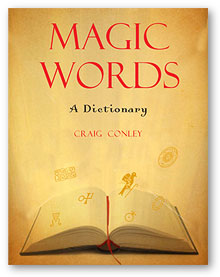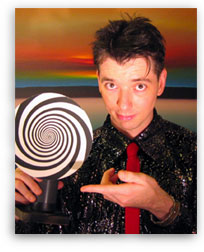|

|
You Are Here:
Deep Aspects of Magic WordsThe Vocabulary of Ritual
As we shall see, the infinite world of magic has room enough for both reverence and self-parody. This dictionary celebrates fun, new forms of magic wordplay, especially those humorous send-ups of the old standards, like ripening abracadabra into have a banana or dancing hocus pocus around to hokey pokey. Clever wordplay—a sort of verbal magic wand—keeps the culture of magic rich, vital, and growing . . . and, of course, entertaining. (Remember, a magician is nothing if not a performer.) Irreverent comical twists serve a legitimate purpose. Nevertheless, the exotic, historical terminology in its authentic form has by no means been rendered useless. Philosopher and law professor William Ian Miller posits that cryptic terms lend an important air of “inaccessibility” to our rituals.1 A magic show is without question its own form of ritual. And Miller defines a “Big R ritual” as one that involves “something that we call, if we do not fear being struck down by some offended power, hocus-pocus” and that can be “distinguished from the small rituals of daily life by a sacred separation.” Miller points out that Rituals are often carried out in a language we don’t understand:
It is this mysterious quality, among other things, that differentiates a Ritual from lower-case rituals like reading the funnies over breakfast or doing the laundry on Sunday. In the same spirit as those magicians who consider the abracadabras of old to be out of touch with modern audiences, religious reform movements “often make the inaccessibility of sacred language to the laity the rallying point of their program,” says Miller. “But that seems to miss the point of what defines sacredness: its inaccessibility. So much of the uncanniness of successful Ritual depends precisely on our not understanding what is said, probably because we think Ritual should be dealing with the mysterious, the incomprehensible, the ineffable.” Certainly our magic show Rituals are meant to be uncanny, mysterious, incomprehensible, and ineffable. And strange, enchanting words from vanished languages can be instrumental in achieving these goals. Miller raises a fascinating question: why, he asks, do people feel more urges to get the giggles during Ritualized experiences than in ordinary settings? Miller alludes to settings like religious services, graduation speeches, weddings, and funerals—events at which most of us have probably observed, or worse yet embodied, that perverse manifestation of involuntary physiology that we laughingly call “the giggles.” Anyone who has ever been overtaken by the giggles knows that it’s no joke, and Miller takes the phenomenon quite seriously. He notes that “The giggles are not brought on by the mere demand to play a role we are not up to playing, for then we would get the giggles every time we feigned interest in a conversation.” He suggests that something distinctly different is at work in Ritualized settings, something that leaves us a little spooked or unsettled. Solemnity virtually dares us not to get the giggles: “More than the willful disobedience in the Garden of Eden, getting the giggles is the profoundest revolt against authority that we have at our disposal, perhaps because it is really not at our disposal but comes unbidden, the very image of unvarnished truth.” Also, “Ritual seems to invite us to suffer breaks with total immersion and see the whole pageant as the highly contrived performance it is. The actors for a mere moment are seen as puppets, mechanical, as ciphers, and this vision is loaded with cosmic possibility.” And the possibilities are not only cosmic but comic, as we see when we relate Miller’s insights to a growing phenomenon in the modern world of magic—the brilliant melding of humor with illusion. Why the emergence of the funny magician as a ubiquitous (to say nothing of commercially-successful) contemporary archetype? From stars like Penn and Teller to the guy who does tricks at your local chain restaurant on Wednesday nights, the marriage of comedy and magic is more than good entertainment—it’s an expression of the very principles that Miller has identified. For it is in his calculated, controlled undermining of the Ritual’s spell, while he continues to carry us along with it, that we recognize the breathtaking brilliance of the skilled comedic magician. No matter how adept his legerdemain or how expert his delivery of a one-liner, the magician-comedian’s most skillful feat of all is to invite the audience to break with the total immersion. He encourages them not to take the tuxedo too seriously, whether it be his own or the garb of his forebears. (In his successful bid to have it both ways, he takes care to wear the tuxedo—and then demystify it—rather than simply appearing in casual attire.) At every turn, he reminds the crowd that the show is a “highly contrived performance” that is yet “loaded with cosmic possibility.” He reveals his pageant to be what Miller calls a mechanical puppet show, but lo and behold, the magician-comedian remains the puppet master, pulling the strings of his spectators by encouraging them to get the giggles. Why is this so important and masterful an accomplishment? Miller notes that “the demand Ritual makes on us to suspend disbelief is at times no easy task,” and the urge to get the giggles is testament to that fact. “Part of the way Ritual achieves a feeling of sacred separation from the commonplace is by not letting you forget that the whole thing is staged and then asking you simultaneously to forget you know that it is staged so that you can be transported by it.” When we reflect on the tension between the sense of immersion and the sense of unreality, some of the unique properties of the Ritualized experience are thrown into focus. Like an absorbing fantasy novel or a lucid dream, an effective Ritual makes the subject at once a skeptical outsider and a fully-involved participant. Moreover, Miller claims that “There is much comic possibility in the contrasting visions.”3 Through his individual style of patter, every magician-comedian admits, whether explicitly or by implication, that his act is just a bunch of hocus-pocus. And yet, as his audience giggles complicitly and aloofly on cue, he forces them to suspend their disbelief by manipulating their very laughter. Perhaps some of the funny magician’s jokes are just throwaways, designed more to buy time and earn audience appreciation than to cagily lampoon his art. But, even here, any successful attempt to “involve” the audience by engaging them with humor ultimately serves the purpose of the Ritual. And in the hands of a masterful trickster, the amused chuckles of a comedy-magic show’s audience and the nervous titters of a Ritual’s assembled can flow back and forth as swiftly as the dice he pours from tumbler to tumbler. Manipulation of the giggles is also intrinsic to the inspired artistry behind another contemporary trend—the “bizarre” magic genre. The shocking bloody finger chops, gross-out illusions, or occult-inspired performances of its practitioners leave their squirming audiences spooked and unsettled, daring anyone not to crack up. Their strange magic words, whether meant to sound uncanny or to produce an uneasy burst of laughter from “thin” air thick with tension, are like insurance policies—incomprehensibility is guaranteed.
NOTES—
next chapter » “Four Archetypes of the Magician” |
|||||||||||||||||||||||||||||||||||||||||||||
 |
About the AuthorCraig Conley is a magic enthusiast and scholar. Recognized by Encarta as “America’s most creative and diligent scholar of letters, words and punctuation,” his intensive and eccentric research has led him to compile a true masterwork entitled Magic Words: A Dictionary. He has also authored One-Letter Words: A Dictionary, among other strange and unusual lexicons, and is a regular columnist for Pentacle magazine. Conley’s ideas are often decades ahead of their time. He invented the concept of the “virtual pet” in 1980, fifteen years before the debut of the popular “Tamagotchi” in Japan. His virtual pet, actually a rare flower, still thrives and has reached an incomprehensible size. Featured Works: Published Works |
|||||||||||||||||||||||||||||||||||||||||||||
|
|
Online Resources |
|||||||||||||||||||||||||||||||||||||||||||||
A free daily symbolic outlook
|
||||||||||||||||||||||||||||||||||||||||||||||